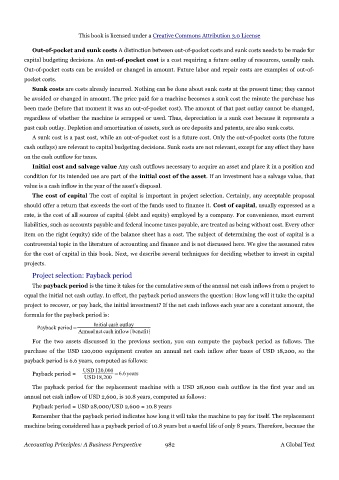Page 981 - Accounting Principles (A Business Perspective)
P. 981
This book is licensed under a Creative Commons Attribution 3.0 License
Out-of-pocket and sunk costs A distinction between out-of-pocket costs and sunk costs needs to be made for
capital budgeting decisions. An out-of-pocket cost is a cost requiring a future outlay of resources, usually cash.
Out-of-pocket costs can be avoided or changed in amount. Future labor and repair costs are examples of out-of-
pocket costs.
Sunk costs are costs already incurred. Nothing can be done about sunk costs at the present time; they cannot
be avoided or changed in amount. The price paid for a machine becomes a sunk cost the minute the purchase has
been made (before that moment it was an out-of-pocket cost). The amount of that past outlay cannot be changed,
regardless of whether the machine is scrapped or used. Thus, depreciation is a sunk cost because it represents a
past cash outlay. Depletion and amortization of assets, such as ore deposits and patents, are also sunk costs.
A sunk cost is a past cost, while an out-of-pocket cost is a future cost. Only the out-of-pocket costs (the future
cash outlays) are relevant to capital budgeting decisions. Sunk costs are not relevant, except for any effect they have
on the cash outflow for taxes.
Initial cost and salvage value Any cash outflows necessary to acquire an asset and place it in a position and
condition for its intended use are part of the initial cost of the asset. If an investment has a salvage value, that
value is a cash inflow in the year of the asset's disposal.
The cost of capital The cost of capital is important in project selection. Certainly, any acceptable proposal
should offer a return that exceeds the cost of the funds used to finance it. Cost of capital, usually expressed as a
rate, is the cost of all sources of capital (debt and equity) employed by a company. For convenience, most current
liabilities, such as accounts payable and federal income taxes payable, are treated as being without cost. Every other
item on the right (equity) side of the balance sheet has a cost. The subject of determining the cost of capital is a
controversial topic in the literature of accounting and finance and is not discussed here. We give the assumed rates
for the cost of capital in this book. Next, we describe several techniques for deciding whether to invest in capital
projects.
Project selection: Payback period
The payback period is the time it takes for the cumulative sum of the annual net cash inflows from a project to
equal the initial net cash outlay. In effect, the payback period answers the question: How long will it take the capital
project to recover, or pay back, the initial investment? If the net cash inflows each year are a constant amount, the
formula for the payback period is:
Initial cash outlay
Payback period=
Annual netcash inflow benefit
For the two assets discussed in the previous section, you can compute the payback period as follows. The
purchase of the USD 120,000 equipment creates an annual net cash inflow after taxes of USD 18,200, so the
payback period is 6.6 years, computed as follows:
USD120,000
Payback period = =6.6years
USD18,200
The payback period for the replacement machine with a USD 28,000 cash outflow in the first year and an
annual net cash inflow of USD 2,600, is 10.8 years, computed as follows:
Payback period = USD 28,000/USD 2,600 = 10.8 years
Remember that the payback period indicates how long it will take the machine to pay for itself. The replacement
machine being considered has a payback period of 10.8 years but a useful life of only 8 years. Therefore, because the
Accounting Principles: A Business Perspective 982 A Global Text

